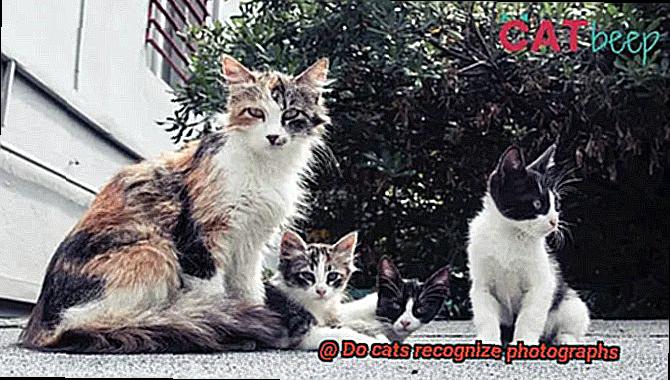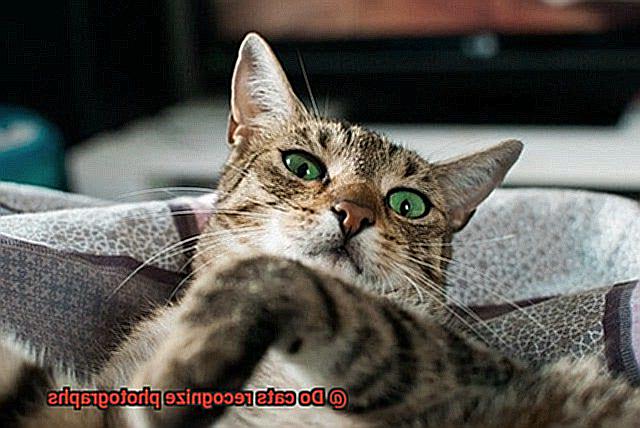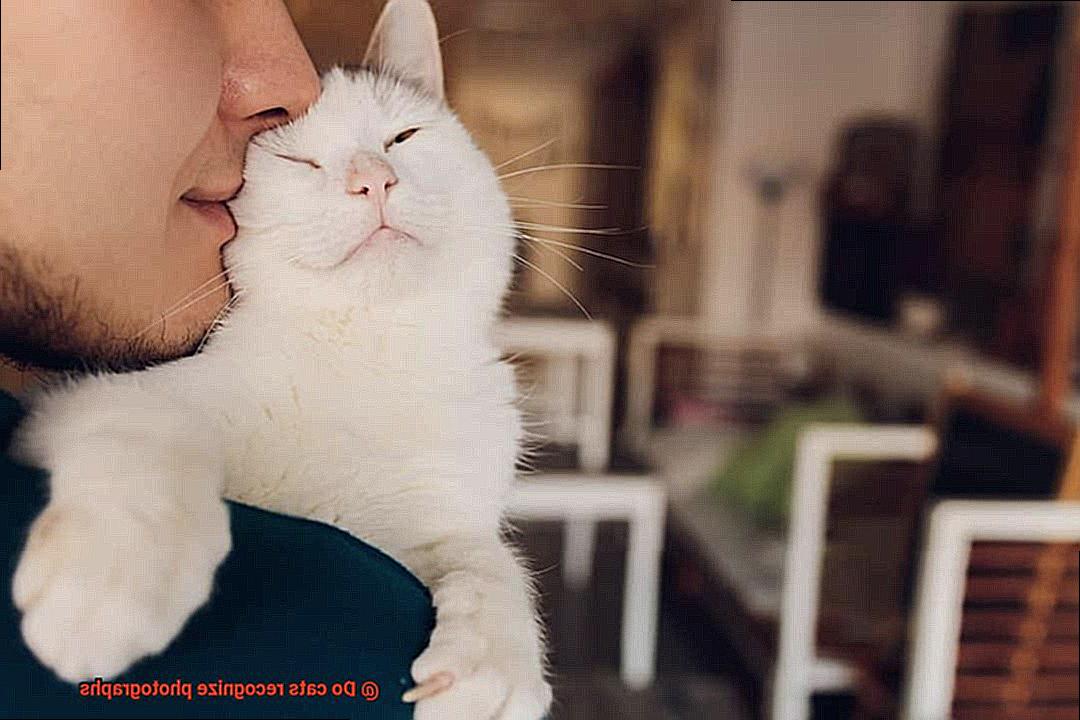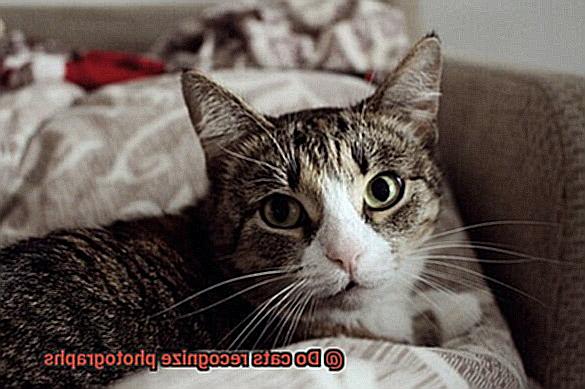Do you love snapping photos of your feline friend, capturing their every adorable moment? Have you ever wondered if your cat recognizes themselves in those photographs? If so, you’re not alone. The question of whether cats can recognize photographs has piqued the interest of pet owners, scientists, and researchers alike.
At first glance, it may seem like a silly question. After all, how could a cat who sees the world so differently than we do possibly recognize a flat image? But recent studies have shown that cats might be more perceptive than we give them credit for. In fact, research has uncovered evidence suggesting that cats can even recognize human faces – particularly those of their beloved owners.
So what about their own images? In this blog post, we’ll take a closer look at the fascinating world of feline perception and explore whether cats are able to recognize themselves in photographs. We’ll delve into the science behind how cats see things and discuss the findings from various studies on this topic. And for all you curious cat owners out there, we’ll offer some insights into how you can better understand your furry friend’s perception of the world around them.

So sit back, relax, and let’s dive into the intriguing question: do cats recognize photographs?
What is a Photograph?
Photographs are not just mere images captured by a camera, but tangible representations of moments in time preserved for posterity. These snapshots allow us to revisit and remember the past, and they have become an essential part of our lives. From a technical perspective, photographs are created when light enters a camera lens and is focused onto a light-sensitive surface. This process generates an image of the subject being photographed, which can then be processed and printed onto paper or displayed on a screen.

The question of whether cats recognize photographs as representations of real-life objects or events has intrigued both cat owners and researchers for years. Studies show that cats do recognize photographs, but their ability to do so depends on various factors such as the quality of the photograph, the familiarity of the subject, and the individual cat’s personality.
If a cat sees a photograph of its owner or a familiar object, it may display signs of recognition such as meowing or sniffing the picture. However, if the photograph is of an unfamiliar object or person, the cat may not show any signs of recognition or interest. Regardless of their recognition ability, it is crucial for cat owners to provide their feline friends with opportunities to interact with real-life objects and people to keep them mentally engaged.
While photographs can capture moments in time, they cannot replace the sensory experiences that come with interacting with real-life objects and people. As pet owners, we should ensure that our pets have access to stimulating environments that help them develop their cognitive abilities.
How Do Cats See?
Cats are fascinating creatures, and their vision is just as intriguing. Their visual system is unique, allowing them to perceive the world in ways that humans cannot. Here’s what you need to know about how cats see.
Firstly, cats have larger pupils than humans, which means they can let in more light. This allows them to see perfectly fine in low light conditions, while we may struggle to see anything at all. Additionally, cats have a reflective layer behind their retina called the tapetum lucidum, which reflects any remaining light back through the retina, enhancing their vision further in dim lighting. Think of it as a natural night-vision mechanism for your furry friend.
Cats also have a wider field of vision than humans, able to see almost 200 degrees compared to our 180 degrees. However, their depth perception isn’t as strong as humans due to the placement of their eyes on the sides of their head rather than facing forward like ours. This means that while they can see a larger area, they may misjudge distances when jumping or swatting at things.
But what really sets cats apart is their acute sense of motion detection. They can detect even the slightest movement from prey animals due to their high concentration of rod cells in their retina, which are sensitive to motion and low light levels. This means that while your cat may seem uninterested in a still object, as soon as it moves, they’ll be ready to pounce.

Understanding how cats see can help us understand how they interact with their environment and recognize certain visual stimuli such as photographs. While studies suggest that cats do have the ability to recognize photographs, real-life interactions are still essential for their cognitive development.

Can Cats Recognize Photographs?
The answer is not as straightforward as one might think.
Cats are known for their exceptional visual memory and recognition skills, which allow them to identify familiar objects and even other cats in photographs. A study conducted by researchers at the University of Tokyo confirmed that cats show more interest in photographs of familiar objects, indicating their ability to recognize them.
However, when it comes to recognizing photographs of humans, the results are mixed. Some studies have shown that cats can recognize their owners in photographs, while others have found no evidence of this ability.
It’s important to note that cats’ response to photographs may differ depending on their individual personality, experiences, and training. If a cat has been trained to associate a specific sound or gesture with a particular photograph, they may be more likely to recognize it.
In essence, while there is evidence to suggest that cats can recognize certain objects and other cats in photographs, their ability to recognize humans in photographs is still up for debate. More research is necessary to fully grasp how cats perceive and process visual information in photographs.
Cats have a unique visual system that enables them to see in low light conditions and detect motion with precision while perceiving a broader field of vision. However, their ability to understand the concept of a flat image representing a three-dimensional human might be challenging for them.

Factors that Affect a Cat’s Ability to Recognize Photographs
Firstly, let’s discuss age. Kittens and older cats may struggle with recognizing photographs due to their developing or declining cognitive abilities and vision. So, if you’re trying to get your cat to recognize a photo of you in your younger years or as a senior citizen, it may prove challenging.
Additionally, breed can play a role in a cat’s visual recognition abilities. Siamese cats, for example, are known for their sharp eyesight and may be more adept at recognizing photographs than other breeds. However, don’t lose hope if your furry companion isn’t a Siamese – there are plenty of other factors at play.
One of those factors is individual personality traits. Curiosity and playfulness may influence a cat’s interest in photographs and ability to recognize them. So, if your cat is easily distracted or disinterested in photos, it could just be their personality.
Lastly, the quality and clarity of the image can make or break a cat’s ability to recognize it. Cats may struggle with blurry or low-resolution images, while clear and sharp images are more likely to catch their attention and be recognizable.
Signs of Recognition in Cats When Seeing Photographs
Cats are known for their exceptional vision, which allows them to see in low light conditions and detect even the slightest movement. With such advanced visual abilities, it’s natural to wonder if cats can recognize photographs. While there is no conclusive evidence to suggest that cats possess the same level of recognition as humans, several studies indicate some signs that suggest they can recognize photographs to some extent.
One of the most apparent signs of recognition is if a cat reacts to a photo of a familiar person or animal. They may stare at the image longer than usual, meow, or even approach the photograph. Some cats may even rub their head against the picture, as if they’re trying to greet the person or animal in it. This behavior suggests that cats have some form of recognition when presented with familiar images.
Another sign of recognition is if a cat shows a change in behavior when they see a photograph. For instance, if a cat sees a photograph of their owner, they may start to purr or become more affectionate. This behavior suggests that the cat recognizes the person in the photograph and is responding accordingly.
However, it’s important to note that not all cats will react to photographs in this way. Some cats may not show any signs of recognition at all, while others may show different behaviors altogether. It’s crucial to remember that cats are individuals with their personalities and preferences; thus, their reactions may vary from one cat to another.
If you want to test your cat’s recognition skills, try showing them photographs of familiar people or animals and observe their behavior. Do they react in any of the ways we’ve mentioned? Or do they merely ignore the photograph and continue with their day? It’s always fascinating to learn more about our feline friends and their remarkable abilities.
Differentiating Between Real-Life Objects and Photographic Images
When it comes to differentiating between real-life objects and photographic images, cats may face some challenges. How can our feline friends learn to tell the difference?
Firstly, studies show that cats may not recognize photographs as representations of real objects initially. This is because cats rely heavily on their sense of smell and hearing to navigate their environment, and visual stimuli may not be as important to them. Therefore, they might perceive photographs as two-dimensional and lack the ability to understand that they are representations of something in the physical world.
Furthermore, cats may have difficulty recognizing familiar objects or people in photographs since photographs are not interactive. Cats demand a more sensory experience to identify something or someone they know. For example, if your cat is familiar with seeing you in person, they may not recognize you in a photograph as quickly.
However, with repeated exposure and training, cats can learn to differentiate between real-life objects and photographic images. One way that cats can distinguish between the two is through association. By associating the image with a specific scent or sound that the cat is familiar with, they can learn to recognize familiar objects and people in photographs. This method helps cats to understand that the photograph represents something in the physical world.
It’s essential to note that individual cats may differ in their ability to recognize photographs. Some felines may be more adept at doing so than others. However, studies suggest that cats may show signs of recognition by staring at familiar images longer, meowing, approaching or even rubbing their head against it as if greeting the person or animal in it.
Does Familiarity Play a Role?
The question of whether cats can recognize photographs is a complex one, as it depends on numerous factors. One crucial factor is familiarity. While cats are known for their sharp eyesight and ability to recognize their owners from afar, this recognition is based on familiarity rather than just the visual cues presented in a photograph.
Research has consistently shown that cats can distinguish between familiar and unfamiliar faces, both human and feline. In fact, a study by the University of Tokyo found that cats could recognize their owners’ faces in photographs, but only if they were presented alongside a familiar object or scent. This suggests that cats rely on multiple sensory cues when recognizing familiar individuals, and that visual cues alone may not be enough.
However, familiarity is not the only factor at play in a cat’s ability to recognize photographs. Previous experiences with individuals or objects can also influence their visual associations. For instance, cats may recognize themselves in mirrors, indicating a level of self-awareness that could translate to their ability to recognize themselves in photographs.

It’s worth noting that while cats are generally able to recognize familiar faces in photographs, there are limits to their recognition abilities. They may struggle to recognize unfamiliar faces or objects, and their recognition may be influenced by factors such as lighting and image resolution.
Stimulating Your Cat with Real-Life Interactions
While cats may not be able to recognize photographs, they do respond to their environment and the people around them. Here are some tips on how to keep your cat entertained and engaged through playtime, grooming, and cuddling.
Playtime is crucial for your cat’s physical and mental well-being. Providing toys such as balls, feather wands, and laser pointers can help keep your cat entertained and encourage them to exercise. Remember, cats are natural predators and enjoy hunting, so toys that mimic prey can be particularly stimulating for them. You can also rotate toys regularly to keep your cat interested and engaged.
Grooming is another great way to interact with your feline friend. Many cats enjoy being brushed or petted, providing an opportunity for you to bond with them whilst keeping their coat healthy and reducing hairballs. So grab a brush, take a seat, and give your cat some much-needed grooming attention. Your cat will appreciate it.
Finally, snuggling up with your cat can provide emotional comfort for both you and your feline companion. Many cats enjoy curling up in their owner’s lap or sleeping next to them on the couch. This type of interaction can help reduce stress and anxiety in cats and strengthen the bond between you both. Take a break from your busy day, enjoy some quality time together, and show your furry friend how much you care.
Conclusion
In conclusion, the question of whether cats can recognize photographs has piqued the interest of pet owners, scientists, and researchers alike for many years. Recent studies have shed light on feline perception, revealing that cats may possess more perceptiveness than we previously thought.
Evidence suggests that cats can even recognize human faces, especially those of their beloved owners. However, when it comes to recognizing photographs of humans, results are mixed.
Various factors such as age, breed, individual personality traits and image quality can all impact a cat’s ability to recognize photographs. Additionally, familiarity plays a significant role in a cat’s recognition abilities. While cats may not initially perceive photographs as representations of real-life objects, repeated exposure and training can help them differentiate between real-life objects and photographic images.
While photographs capture moments in time, they cannot replace the sensory experiences that come with interacting with real-life objects and people. As responsible pet owners, it is crucial to provide our feline friends with opportunities to interact with real-life objects and people to keep them mentally stimulated. Playtime sessions, grooming routines and snuggling up together are all great ways to interact with your cat while strengthening your bond.
Understanding how cats see can help us comprehend how they interact with their environment and identify certain visual stimuli such as photographs.

